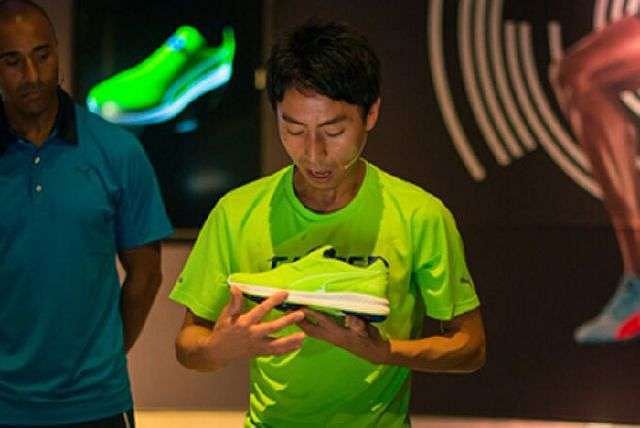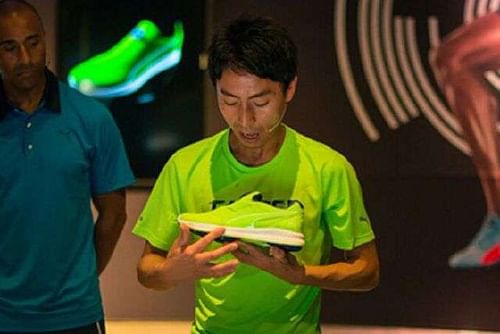
The brains behind Usain Bolt's Olympic shoes: meet Kohei Hagio

The trip so far had already been intriguing enough, with several pleasant surprises in store and on our itinerary for the trip. This was something special, however. After a day spent meeting not one athletics legend but two – with both Usain Bolt and World Championships record holder holder Colin Jackson speaking to – and laughing with – our group, we were taken to an ‘undisclosed location,’ forewarned only to “make sure you carry your passports.”
On our shuttle to this location, we all wondered where we really were headed – and that turned out to be what looked like a small, relatively abandoned airport. Discussions and theories flew fast as we lined up to have our passports checked by actual aviation officials stationed at the venue.
A long but relatively quick line, security checks, frisking and scans later, we were ‘cleared’ – but unsure for what.
We were each given a standard issue ‘day pass’ for access to the airfield, where nobody was still aware what was going on. In scenes strongly reminiscent of Men in Black, our group stood on an old private airfield, rubbing shoulders with small private jets, gliders and the odd Cessna just parked there, waiting to be whisked off to a new destination – much as we had been.
Directed onto the apron in near pitch-darkness, we were greeted by X Files-esque music and a countdown as the hangar in front of us opened to reveal PUMA’s newest shoes – the Disc Ignite and the Disc Spike, both of which will be used by Usain Bolt at Rio, and each of which we were given a pair of.
The engineering behind the shoes is tried and tested – by multiple world champions, no less. Welsh sprinting legend Colin Jackson wore them as he won the 1993 World Championship gold in Stuttgart, Germany – marking the earliest stages of a 44-race undefeated run.
Just a year earlier, German track-and-field star Heike Drechsler had worn the DISC spikes to perform at the 1992 Olympic Games in Barcelona, Spain – and with immense success. She won gold in the long jump that year, and wearing shoes far ahead of their time.
The DISCs have an internal framework of wires that support the foot and make the shoe more efficient, form-fitting and convenient than regular spikes. The framework was external then, but in the two decades since, they have made more than aesthetic advancements, PUMA Creative Director Kohei Hagio tells me.
“You see this,” he says, pointing to a mass of metal and wires mounted on Colin Jackson’s championship-winning shoes. “It’s outside, it’s big,” now you see this? We look at the new shoes – sleek, streamlined, and not a hint of the complex engineering inside the shoe visible on the outside. “All that engineering, all that support, it's still inside, but this is so much easier, so much lighter for the athlete as well.”
He may be the driving force behind how the shoe eventually turns out, but he takes opinions from every corner. “We asked Usain what he likes before we designed this, we took his input in. It’s so important to know what the athlete is looking for, what he or she wants, and we can help adapt to those needs.”
The shoes were also used by the young athletes at Champs, or the Junior National Championships, which sees young track-and-field talent from schools across Jamaica compete for top honours.
They may be high schoolers, but their opinion was crucial to Kohei’s adapted design, he said. “We spoke to them, too. They’re young, so they focused a little more on the aesthetic appeal. They liked how it looked. But then, when they tried out the fit, practiced in it, they found that comfortable, they were able to run very comfortably. The cushion adapted to their gait, the shoe hugged the foot with minimal trouble, and it was so convenient and streamlined.”
The teenagers all put in excellent performances later that evening – watched from the stands by us, a group of journalists amazed at the wealth of track and field talent Jamaica has to offer, year after year, generation after generation. The atmosphere was electric, too – the country is clearly passionate about its athletics, and it’s not hard to see why.
We also met two emotional rising stars of Jamaican athletics – Hansle Parchment and Jevon Francis. Francis is a former star of Champs, and spoke not only of his passion for the sport and love for the shoes, but the immense support he received from PUMA in being able to compete and train.
“It’s not just for the athletes, though,” Kohei signs off. “It’s convenient, easy but that doesn’t mean it doesn’t provide just as much support as a ‘regular’ running shoe.”
The wire framework means that the shoe can essentially adapt to the wearer’s feet, rather than necessitating a runner to have to search for shoes to fit ‘problem areas’ with their feet.
He may be on top and working with the best, but Kohei still has time for the youngest wearers of his shoes – whom he spoke to only a few hours before we met.
The world’s best will now use the shoes on the world’s biggest sporting stage as the Jamaican contingent head to Rio 2016, in the quest for more Olympic glory – and perhaps a few more world records in the process.